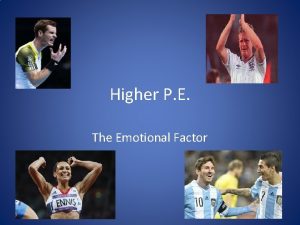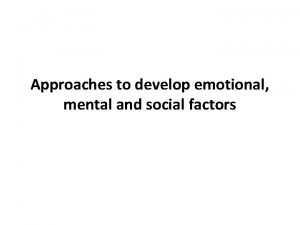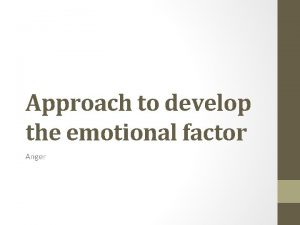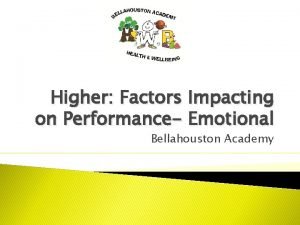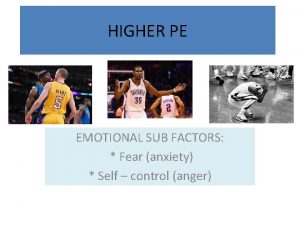Higher PE Emotional Factors Emotional Factors The main










- Slides: 10

Higher PE Emotional Factors

Emotional Factors The main emotional factors that impact on performance are; • Happiness/Sadness • Anger • Fear

Happiness/Sadness Is an emotional state of mind. Ranging from feeling content and joy (happy) to a feeling of despair, grief or sorrow (sad). Happiness and sadness can impact on numerous factors such as confidence, self-belief in your own ability, resilience, and your ability to realise your potential. For example, being in a happy state of mind before playing basketball will increase your confidence in executing skills and your self-belief in performing them successfully. If you were sad before playing a game of football, your confidence and belief in your ability to perform skills successfully will be low resulting in a poorer level of skill execution

Anger An emotion whereby the individual has normally been offended, denied, wronged and a tendency to react through retaliation. It is a strong, uncomfortable emotion after being provoked. Anger in sport can be very useful in the right situation but more often than not it is about how you control your aggression that makes the difference. Opponents look to ways of irritating each other in the hope it puts them off a game plan or affects their performance.

Fear is an emotion induced by a perceived threat, which causes you to quickly pull away or, in sporting terms, usually hide. Fear produces negative thoughts, which directly impact on a sportspersons confidence. Confidence has a direct response to performance. If you fear an opponent or opposition then it is likely that your own performance level will drop significantly which will make it easier for opposition to compete.

Gathering Information on Emotions • Gathering information can be characterised in terms of Quantitative and Qualitative Data. • Quantitative data is concerned with facts and figures and provides statistics and a measurement of performance in related areas.

Gathering Information on Emotions • Qualitative methods are ways of collecting data which are concerned with describing meaning, rather than with drawing statistical inferences. Methods include interviews and receiving feedback from a coach or teacher.

Gathering Information on Emotions An example of this Qualitative Data would be for a performer to complete an Emotional Questionnaire which gathers information on the emotional state of the performer prior to beginning a skill development programme or prior to competition. (Sport Emotion Questionnaire)

Question Analyse a method you used to gather information on an Emotional factor that impacts on football

Example Think of examples to use that you can relate to e. g. ". . . my putting was not particularly good during the round and I was becoming more frustrated angry with my inability to score well. After one very poor putt I made the silly mistake of allowing my anger to boil over and at the next tee tried to drive the ball much further than normal. My technique was awful and I put my drive into trees. This only added to my poor scoring. . . "

